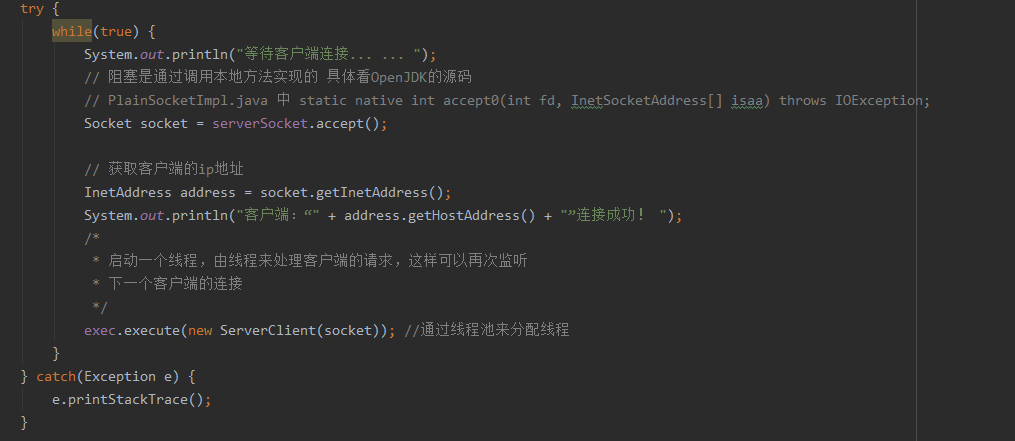
accept()执行后,会阻塞等待连接。我想知道底层是怎么实现阻塞的,于是一步步跟进去看,是在哪一步阻塞的。
于是我下载了OpenJDK8,一开始我的JDK是12.0.1,accept()在PlainSocketImpl.java中调用的是native方法,accept0()。我在OpenJDK8中找到了PlainSocketImpl.c文件,
但是没有找到accept0()方法。于是我重新下载了JDK1.8。现在在Oracle下载JDK要注册账号了。之后再跟进去看,发现这时候调用的还是accept0()方法,
但是文件是DualStackPlainSocketImpl.java而它的c文件,在OpenJDK中windows文件夹下,这里推荐一个好用的搜索文件的软件Everything。我的系统是win10,猜测如果是linux,可能就在其它文件夹下了。
果然我找到了accept0()方法。这里调用了accept函数。显然它定义在头文件中。

在系统中找到了头文件winsock2.h。

函数声明在这里。但是找不到对应的实现。想到linux中应该有类似开源的源码。

在一个博客上找到了linux中TCP accept的实现,这里我没那么严谨,取自己找到源码来读(暂时能力和精力有限哈)。https://blog.csdn.net/mrpre/article/details/82655834
其中重要的是这段代码。我以为底层是通过for(;;)实现的阻塞,但是对于每个进程for(;;)只会执行一次,那为什么这么写,主要是历史遗留原因,博主也有说明。那么阻塞是怎么实现的呢?最核心是schedule_timeout函数。于是又找到了源码。

注意上图中首先将进程加入到等待队列里面,并设置为可中断。schedule_timeout是理想的延迟方法。会让需要延迟的任务睡眠指定的时间。最核心的是schedule函数。
它的前后是设置定时器,和删除定时器。定时器到指定时间会唤醒进程,重新加入就绪队列。但是我们知道在每到指定时间的时候也可以唤醒进程,就是因为设置了可中断。
看来是schedule实现了阻塞。找来了它的源码。
signed long __sched schedule_timeout(signed long timeout)
{
struct timer_list timer;
unsigned long expire;
switch (timeout)
{
case MAX_SCHEDULE_TIMEOUT: //睡眠时间无限大,则不需要设置定时器。
/*
* These two special cases are useful to be comfortable
* in the caller. Nothing more. We could take
* MAX_SCHEDULE_TIMEOUT from one of the negative value
* but I' d like to return a valid offset (>=0) to allow
* the caller to do everything it want with the retval.
*/
schedule();
goto out;
default:
/*
* Another bit of PARANOID. Note that the retval will be
* 0 since no piece of kernel is supposed to do a check
* for a negative retval of schedule_timeout() (since it
* should never happens anyway). You just have the printk()
* that will tell you if something is gone wrong and where.
*/
if (timeout < 0) {
printk(KERN_ERR "schedule_timeout: wrong timeout "
"value %lx
", timeout);
dump_stack();
current->state = TASK_RUNNING;
goto out;
}
}
expire = timeout + jiffies;
setup_timer_on_stack(&timer, process_timeout, (unsigned long)current);
__mod_timer(&timer, expire, false, TIMER_NOT_PINNED);
schedule();
del_singleshot_timer_sync(&timer);
/* Remove the timer from the object tracker */
destroy_timer_on_stack(&timer);
timeout = expire - jiffies;
out:
return timeout < 0 ? 0 : timeout;
}
内核版本2.6.39。schedule主要实现了进程调度。即让出当前进程的CPU,切换上下文。既然切换到其它进程执行了,而当前进程又进入了等待队列,不再会被调度。直到时间结束,或者中断来。这时候会从schedule返回。删除定时器。根据返回的timeout值判断是否大于0判断是睡眠到时间被唤醒,还是因为有连接了提前唤醒。
具体的代码细节没有进一步深究,然后理解可能也是错的。以后继续深入吧。
/*
* schedule() is the main scheduler function.
*/
asmlinkage void __sched schedule(void)
{
struct task_struct *prev, *next;
unsigned long *switch_count;
struct rq *rq;
int cpu;
need_resched:
preempt_disable(); //禁止内核抢占
cpu = smp_processor_id(); //获取当前CPU
rq = cpu_rq(cpu); //获取该CPU维护的运行队列(run queue)
rcu_note_context_switch(cpu); //更新全局状态,标识当前CPU发生上下文的切换。
prev = rq->curr; //运行队列中的curr指针赋予prev。
schedule_debug(prev);
if (sched_feat(HRTICK))
hrtick_clear(rq);
raw_spin_lock_irq(&rq->lock); //锁住该队列
switch_count = &prev->nivcsw; //记录当前进程的切换次数
if (prev->state && !(preempt_count() & PREEMPT_ACTIVE)) { //是否同时满足以下条件:1该进程处于停止状态,2该进程没有在内核态被抢占。
if (unlikely(signal_pending_state(prev->state, prev))) { //若不是非挂起信号,则将该进程状态设置成TASK_RUNNING
prev->state = TASK_RUNNING;
} else { //若为非挂起信号则将其从队列中移出
/*
* If a worker is going to sleep, notify and
* ask workqueue whether it wants to wake up a
* task to maintain concurrency. If so, wake
* up the task.
*/
if (prev->flags & PF_WQ_WORKER) {
struct task_struct *to_wakeup;
to_wakeup = wq_worker_sleeping(prev, cpu);
if (to_wakeup)
try_to_wake_up_local(to_wakeup);
}
deactivate_task(rq, prev, DEQUEUE_SLEEP); //从运行队列中移出
/*
* If we are going to sleep and we have plugged IO queued, make
* sure to submit it to avoid deadlocks.
*/
if (blk_needs_flush_plug(prev)) {
raw_spin_unlock(&rq->lock);
blk_schedule_flush_plug(prev);
raw_spin_lock(&rq->lock);
}
}
switch_count = &prev->nvcsw; //切换次数记录
}
pre_schedule(rq, prev);
if (unlikely(!rq->nr_running))
idle_balance(cpu, rq);
put_prev_task(rq, prev);
next = pick_next_task(rq); //挑选一个优先级最高的任务将其排进队列。
clear_tsk_need_resched(prev); //清除pre的TIF_NEED_RESCHED标志。
rq->skip_clock_update = 0;
if (likely(prev != next)) { //如果prev和next非同一个进程
rq->nr_switches++; //队列切换次数更新
rq->curr = next;
++*switch_count; //进程切换次数更新
context_switch(rq, prev, next); /* unlocks the rq */ //进程之间上下文切换
/*
* The context switch have flipped the stack from under us
* and restored the local variables which were saved when
* this task called schedule() in the past. prev == current
* is still correct, but it can be moved to another cpu/rq.
*/
cpu = smp_processor_id();
rq = cpu_rq(cpu);
} else //如果prev和next为同一进程,则不进行进程切换。
raw_spin_unlock_irq(&rq->lock);
post_schedule(rq);
preempt_enable_no_resched();
if (need_resched()) //如果该进程被其他进程设置了TIF_NEED_RESCHED标志,则函数重新执行进行调度
goto need_resched;
}